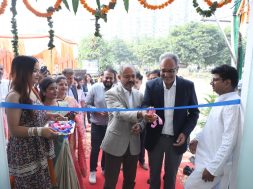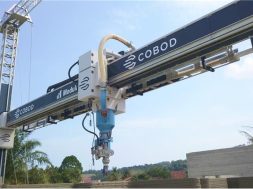Beneath India’s road tunnels
With a rising number of tunnel projects being constructed in the country, a sneak into what are the challenges and technology used for constructing road tunnels
Road transport has emerged as the dominant segment in India’s transportation sector with around 3.3 million kilometres road network – the second largest in the world, consisting of national highways (NHs), state highways (SHs), major district roads (MDRs) and rural roads (RRs) that include other district roads and village roads.
Road tunnels in IndiaIndia is one of the fastest growing markets for tunnel construction. Major growth drivers are railways, highways, water resources and hydropower, metro rail, and urban utility projects. Tunnel works have gained momentum in the last 10-15 years and will further increase with major investments envisaged for country’s infrastructure in the near future. Around 45 billion USD is expected for the construction of tunnel.
“Tunnel construction in roads and highway sector has also seen growth with NHAI and various other implementing agencies coming up with new road tunnel projects that are in various stages of planning and construction in various parts of country,” says Heman Manchanda, Manager – Geotechncial, Geodata India Pvt. Limited. Though to date we have only around 11 kms of road tunnels constructed (out of 1,508 kms of total constructed tunnels in India); another 49kms of road tunnels is under construction and 120 kms at an investment of about USD 2.5 billion are at various stages of planning and approval from nodal agencies. Though these figures are still on lower side as compared to total tunnel construction projects being envisaged in India (975kms under construction, and 1,830 kms under planning); there is a constant intention to go more and more underground even for road transport. .
He further adds, “Using tunnels as a key enabler for integrated transport and environmental improvement schemes in rural areas, can deliver outstanding environmental benefits, albeit at high cost, in areas of outstanding natural beauty.” Several highway tunnels are utilised in mountainous terrain where building the roadway on the outside could be very difficult. The benefit of tunnels in mountainous environment will improve the roadway alignment and reduce the vertical grade.
The Chenani-Nashri Tunnel which is being blasted through the Mury formation range of the Shivalik range — derived from Mury village in Pakistan from where it starts — at an elevation of 1.2 km is 9 km long and will be the longest tunnel in the country when completed in 2016. The 8.8 km Rohtang Tunnel is the world’s longest road tunnel being built at an altitude of 10,000 feet. “Road tunneling has a history of more than 100 years with maximum excavations in the Himalayan ranges. All the excavated tunnels whether it is for road or railways have shown favorable status and are still intact till date without a question mark on their stability,” states Ajay Mishra, Managing Director, Segmental Consulting & Infrastructure Advisory (P) Ltd. In Himachal Pradesh, Kiratpur – Nerchowk project NH-21 has 5 tunnels. 4 main tunnels and 1 escape tunnel are under construction in sedimentary rocks (sand stone, clay stone shale, and silt stone). The overall development of road tunnels in India has emerged successfully by virtue of proper geological assessment of rocks, geotechnical studies, and appropriate excavation of tunneling within the scope of design parameters and technical specifications.
Technologies used in tunnel constructionIn most of the tunnel construction, Q value system of N.Barton (1974) and RMR system of Z.T. Bieniauski (1973-1989) are being followed to find out exact rock mass class and its suitable support system and this has proved to be most successful. However, New Austrian Tunneling Method (NATM) (1957-64) and Russo’s multiple chart system (2007) (Drill and Blast) by heading and benching method is also being followed nowadays in most of the projects such as Chenani-Nashri highway tunnel in (Jammu & Kashmir) and in all 5 Tunnels of Kiratpur-Nerchowk section of Himachal Pradesh cut and cover, a simple method for shallow tunnel is also adopted. From the view point of risk management; the correct choice of the excavation methods for a given tunnel is the “first risk-mitigation measure” or simply, the primary response to the identified principal risks. A robust approach should be adopted for determining the optimal method (or combination of methods) of construction for a tunnel, based on the principles of risk analysis and multi-criteria analysis. In making the correct choice for a given project, the presence or absence of adverse conditions and if present, the frequency of their occurrence in a given tunnel section are of paramount importance to the choice. The point is to recognise the risks as most risks can be effectively managed through the use of a Risk Management Plan, or RMP for short, a robust, transparent and effective methodology, which can be adopted from the early design stages to the construction and operation phases, to minimise the occurrence of risks and mitigate their consequences.
Common methods of tunnel construction include: drill and blast, with support being provided with either the New Austrian Tunneling Method (NATM) or sets and bracing; shield tunneling; tunnel boring machines (TBMs); sunken tube tunnels for underwater crossings; and cut-and-cover tunnels. TBM methods are best suited to soft ground tunneling whereas drill blast/NATM to hard rock tunneling. For intermediate ground conditions, a road header, with or without a shield, or tunnel jacking can be used depending on the consequences of ground movement.
A TBM generally is a device for excavating a tunnel in such a way that the material to be removed is disintegrated by the continuous rotation of a group of cutting tools thrust against the surface of the material at the working face. A TBM works most efficiently in relatively homogeneous ground, (all soft or all hard), because it is very difficult to change cutters during the tunneling process. For mixed ground, where the tunnel passes from soft to hard ground, or visa-versa, NATM is usually a more economical tunnel method.
Determining appropriate methodsFactors that affect the selection of tunnel construction method vary from geological to economical to sociological. Geological factors often effect economical considerations because ground conditions such as whether the tunnel passes through rock, soil or mixed ground can drive the construction method decision since some methods are more efficient in certain ground conditions. Shallow tunnels are often constructed using cut and cover techniques, especially in urban areas. Tunnels that cross bodies of water can be either bored or constructed using sunken tubes depending on the depth of the water, ground conditions and the length of the tunnel. Jacked tunnels have been used in urban areas to construct tunnels under active transportation facilities. An engineer having experience of various methods of tunnel construction will be best equipped to help an owner/operator select the best method(s) of tunnel construction for their project.
Geographical challengesRoad tunnels in hilly terrains may have to pass through varying geographical conditions like active faults, tectonically disturbed zones, karstic forms, Cavities, voids, water inflow zones, Abrasive/resistant/hard materials, zones of In-situ stress anisotropy, Swelling clay minerals etc.
Related hazards include rock wedge instability, pronounced tendency to rock fall, mild brittle failure even associated to rock minor rock block ejection, sudden and violent brittle failure, rock block ejection, development of plastic/viscous deformations resulting in a significant extrusion of tunnel face and radial convergences, intense development of plastic/viscous deformations, resulting in a large extrusion of tunnel face and radial convergences, severe gravity-driven instability, with immediate collapse of the tunnel face/excavation contour.
One of very common problem specifically in Himalayan regions is over break. It can be controlled in tunnel blasting, as in general rock slope blasting, by using controlled blasting techniques such as pre-splitting, trim blasting and line drilling which work best in massive rock formations. In geologically complicated material a simple crack does not form between adjacent blast holes. There is a broken shatter zone that forms that serves to act as protection for the final rock face from the effects of radial cracks emanating from the production blast holes.
Detailed geological investigations along the tunnel alignment and in its vicinity should be carried out seriously before going for excavation of tunnels. Proper rock mass class should be worked out by assessing correctly all the geological parameters exposed on the tunnel face after each blast. If these geological parameters are not assessed correctly, then you cannot expect correct results from the rock mass classes as these geological parameters are the back bone of all the rock mass classifications which suggest us to install a proper support system to be installed within their stipulate stand-up time. So, proper assessment of Geological parameters, correct evaluation of rock mass class and installations of suitable support system are the biggest challenges to work out for its implementation.
Economical ChallengesThere are many factors affecting the economics of a tunnel. A tunnel is composed of many elements. Every tunnel is different depending on where it is located, its use, method of construction, environmental and safety requirements. “Tunnels need to be designed with a proper cross section to effectively and efficiently provide a safe passage for its users, some kind of lighting always needs to be provided, and proper ventilation, security and safety requirements are always needed,” says Mr Manchanda. Road Tunnel costs depend on many factors and variables. For example, these factors and variables include, depth of tunnel, need for temporary support of excavation, geometric dimensions of the structure, materials to be used, need for safety and security systems, traffic volume, need for temporary structures, utility relocation, soil properties, location of water table, loads to be supported by the tunnel, and mitigation of environmental impacts. “Over designing of support system is the main challenge which is being faced by the developers in most of the ongoing projects in India,” remarks Mr Mishra.
Solutions for good quality road tunnelsRoad networks in India are being constructed using best of engineering practices adopting state of the art technologies. However, some of them are now showing signs of premature failure due to cumulative effect of inadequate maintenance and structural inadequacies to cater the need of increased traffic volume and heavy axle loads.
We build roads and remember them only when they reach in extremely bad condition. The pavement management system and the systematic approach contained are not adequately implemented for repairs and rehabilitation. Road maintenance forms part of the works carried out to provide adequate transport infrastructure. Speaking on the technical points for quality tunnel construction Mr Manchanda says, “There is no shortage of technical guidance on how the works should be carried out. The challenge seems to be more related to how maintenance should be organised and when it should be carried out.”
Quality of roads can be improved by optimum utilisation of available resources and blending of quality materials to achieve the required quality as per specification requirements. During construction stage, the supervision should be strictly monitored. “In India, we have to make effective planning and its implementation for periodic repair and maintenance of constructed roads, which is at present inadequate,” concludes Mr Mishra.
Over designing of support system is the main challenge which is being faced by the developers in most of the ongoing projects in India.________________________________Ajay Mishra, Managing Director, Segmental Consulting & Infrastructure Advisory________________________________
Tunnels need to be designed with a proper cross section to effectively and efficiently provide a safe passage for its users.
Heman Manchanda, Manager – Geotechncial, Geodata India________________________________
76
Cookie Consent
We use cookies to personalize your experience. By continuing to visit this website you agree to our Terms & Conditions, Privacy Policy and Cookie Policy.









